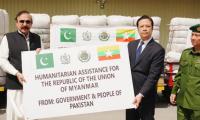LAHORE: As Federal Law and Justice Minister Farogh Naseem’s observation that the water-starved Karachi should be made a separate administrative unit constitutionally by invoking Article 149(4) has evoked a strong reaction from largest national political entities.
One wonders as to why the federal government can’t brainstorm the possibility of designating this largest Pakistani city as the country’s ‘second capital’ to address its chronic woes - once and for all!
More: What Article 149 says about federal government's powers?
Instead of mulling the idea of taking over the direct administrative control of this Metropolitan, as Opposition parties think the PTI government might be planning to do, a debate on having Karachi as the ‘second capital,’ might yield fruitful results and may not attract a severe criticism from most stakeholders.
Littered with uncontrollable filth, garbage, deplorable roads inundated with stagnant sewage water, traffic congestion, broken and naked live electricity wires posing serious life threats, unmanaged air pollution and rampant street crime especially since 1985, the former Pakistani capital of Karachi may be bracing to become the world’s third most populated city by 2030, as a London-based global market research firm Messrs “Euromonitor International” had recently predicted, but it is surely reeling under a crumbling infrastructure and a near collapse of civic amenities at present.
Related: Bilawal calls talk of Article 149 conspiracy against Sindh
Although the current population (officially 14.9 million in the 2017 census) of this grand old port city is expected to grow by more than 30 percent, the second highest international growth rate, between 2017 and 2030, it remains at number 9 in terms of growth in the real GDP — as Dhaka tops the list, the “Euromonitor International” had revealed.
A peek into Karachi’s governance history: Research conducted by peeking into official websites and chronicles shows the first form of government in Karachi was established in 1846 to control the spread of cholera. This governing board became a municipal commission in 1852 and a municipal committee the following year. The Karachi Municipal Act of 1933 had transformed the city administration into a municipal corporation with a mayor, a deputy mayor and 57 councillors. In 1948, the Federal Capital Territory of Pakistan, comprising approximately 2,103 square kilometres (812 square miles) of Karachi and its surrounding areas, was created, but this was merged into the province of West Pakistan in 1961. However, the municipal corporation remained in existence and in 1976 became a metropolitan corporation, followed by the creation of zonal municipal committees, which lasted until 1994. Two years later, the metropolitan area was divided into five districts, each with a municipal corporation of its own. In 2001, the five districts of Karachi were merged to form the city district of Karachi. It was structured as a three-tier federation, with the two lower tiers composed of 18 towns and 178 union councils.
In 2011, City District Government of Karachi was de-merged into its five original constituent districts namely Karachi East, Karachi West, Karachi Central, Karachi South and District Malir.
These five districts form the Karachi Division now. There are also six military cantonments that are administered by the Pakistan Army. Karachi had served as Pakistan’s capital from the country’s inception to 1963, when the country’s military ruler Ayub Khan had replaced it with Islamabad, a picturesque town nestled in the foothills of the Himalayas. The then Ayub Khan regime had asserted that Islamabad’s location gave it an advantageous position to defend, maintaining it was also close to the military headquarters in Rawalpindi for logistic convenience.
The government of the time had further contended that Islamabad was hard to invade from the North, East and West as it was surrounded by mountains in all those directions, arguing that if any enemy country like India invaded Karachi from the South, it would have to pass hundreds of miles of hostile land and cross many rivers and canals to reach Islamabad. Founded as the fortified village of “Kolachi” in 1729, Karachi’s metropolitan area is spread over 3,530 square kilometres. Some other sources say Karachi’s total area stands at 3,780 square kilometres. Recently, Karachi has flashed headlines internationally, in quite a shameful way though. According to a Berlin-based firm Messrs ABCD’s “2018 Cannabis Price Index,” Karachi is the second-highest global consumer of drugs like cannabis and hashish, with annual consumption resting at 41.95 metric tonnes or 41,950 kgs, just behind New York, where 77.44 metric tonnes of these drugs are used annually. Boasting of contributing approximately 30 percent to Pakistan’s manufacturing sector and serving as the major national revenue generating and collection centre, this city not only houses the Karachi Stock Exchange, the largest bourse in the country, but offices of some of the major foreign multinational corporations operating in Pakistan are also located here. Then, we have the State Bank of Pakistan head office here and the headquarters of various national and global banks. The Jinnah International Airport of Karachi is the largest and busiest airport of Pakistan; handling over 10 million passengers a year. This airport receives the largest number of foreign airlines. A total of 35 airlines and cargo operators fly to Jinnah International predominantly from the Middle East and Southeast Asia. It was a renowned global tourist destination over three or four decades ago when it was called the “City of Lights”. The largest shipping ports of Pakistan are the port of Karachi and the nearby Port Qasim, both in Karachi. Not long ago, the Port Qasim Authority had announced that an implementation agreement was being signed for the development of pollution-free coal, cement and clinker terminal worth $175 million with a handling capacity of up to eight million tonnes per year at port.
Here follows the list of countries with two Capital cities: Research undertaken by the Jang Group and Geo Television Network reveals that while several nations on the world map have two capitals, South Africa has had three different capitals (Bloemfontein, Cape Town and Pretoria) for its judicial, legislative and executive branches at the federal level since 1910, when the four founding provinces of South Africa, Cape Colony, Orange River Colony, Transvaal Colony and Natal Colony, could not decide a capital city that could be shared by all. Unlike most countries on this list the Netherlands has always had two capitals, Amsterdam and The Hague. Amsterdam has been the official and constitutionally mandated capital of the country since 1814 when the new kingdom of the country was formed following freedom from French rule. However, The Hague has been the seat of basically all government functions for the country since 1588, only some years after the establishment of the Republic of the United Netherlands. South Korea has Sejong City and Seoul as its capitals), Sri Lanka has Colombo and Kotte, Malaysia has Kuala Lumpur and Putrajaya, Benin (Cotonou and Porto-Novo), Tanzania (Dar es Salaam and Dodoma), Chile (Santiago and Valparaiso), Georgia (Kutaisi and Tbilisi), Bolivia (Santiago and Valparaiso), Ivory Coast (Abidjan and Yamoussoukro), Western Sahara (Laayoune and Tifariti), Swaziland (Lobamba and Mbabane), Honduras (Comayaguela and Tegucigalpa), and Montenegro has Podgorica as the official capital where all of the country’s government functions take place and the city of Cetinje as its historical capital.
It is imperative to note that Israel designates Jerusalem as its capital, and seats its government in that city. However, as Jerusalem’s political status has not reached a final settlement; most countries locate their embassies in Tel Aviv. Both Tel Aviv and Jerusalem had served as de facto joint capitals of Israel from May to December 1948. The Israeli parliament and the Supreme Court are both located in Jerusalem, which makes it the legislative capital and judicial capital of Israel. In Germany, the highest judiciary organs like the Federal Court of Justice and the Federal Constitutional Court are located in Karlsruhe, whereas the nation’s political capital is Berlin. Some ministries are still mainly located in Bonn, the former West Germany’s capital. In the case of Russia, during 2009, the Constitutional Court of the country was moved from Moscow to St Petersburg, giving the latter city some of the expected functions of a capital.







